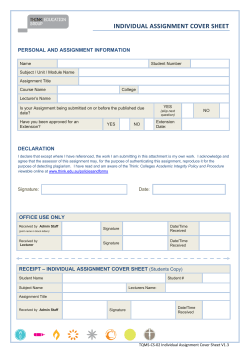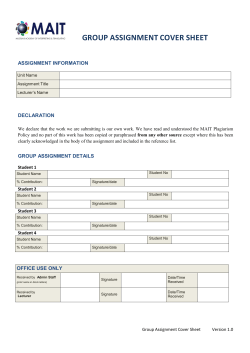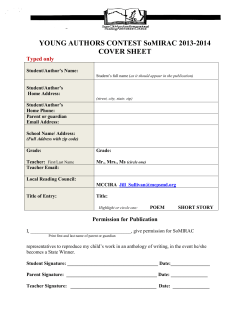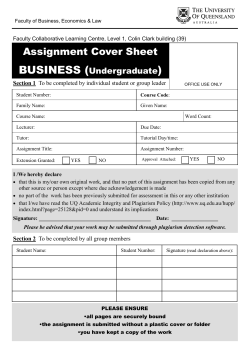
ARIEL2: A phase 2 study to prospectively respond to rucaparib
ARIEL2: A phase 2 study to prospectively identify ovarian cancer patients likely to respond to rucaparib Elizabeth Swisher,1 James Brenton,2 Scott Kaufmann,3 Amit Oza,4 Robert L. Coleman,5 David O’Malley,6 Gottfried Konecny,7 Ling Ma,8 Maria Harrell,1 Dan Visscher,3 Andrea Wahner Hendrickson,3 Kevin Lin,9 Mitch Raponi,9 Elaina Mann,9 Heidi Giordano,9 Lindsey Rolfe,10 Jeff Isaacson,11 Roman Yelensky,12 Clare Scott,13 Andrew Allen,9 Iain McNeish14 of Washington School of Medicine, Seattle, WA; 2Cancer Research UK Cambridge Institute, Li Ka Shing Centre, University of Cambridge, Cambridge, UK; 3Mayo Clinic, Rochester, MN; 4Princess Margaret Hospital, Toronto, Canada; 5The University of Texas MD Anderson Cancer Center, Houston, TX; 6The Ohio State University, James Cancer Center, Columbus, OH; 7University of California, Los Angeles (UCLA), Los Angeles, CA; 8Rocky Mountain Cancer Center, Lakewood, CO; 9Clovis Oncology, San Francisco, CA; 10Clovis Oncology, Cambridge, UK; 11Clovis Oncology, Boulder, CO; 12Foundation Medicine Inc., Cambridge, MA; 13The Royal Melbourne Hospital, Melbourne, Australia; 14Institute of Cancer Sciences, University of Glasgow, Glasgow, UK 1. 1University 1 Disclosures • Dr. Swisher’s EORTC-NCI-AACR 2014 travel-related expenses were paid for by Clovis Oncology 2 Today’s Presentation • A genetic signature identifying a BRCA-like phenotype has been developed by Clovis Oncology • Ovarian cancer is commonly associated with homologous recombination (HR) deficiency, both BRCA-mutated and BRCA-like • The ARIEL2 study assesses the utility of tumor BRCA mutations and the BRCA-like signature in predicting response to rucaparib, a potent PARP inhibitor, in women with platinum-sensitive, relapsed ovarian cancer • Interim data from the ARIEL2 trial will be presented PARP=poly (ADP-ribose) polymerase. 3 PARPi, used in the genetic context of HRD, drive synthetic lethality HR is a complex process requiring coordinated function of many gene products, such as BRCA1, BRCA2, PALB2, RAD51, etc PALB2 Cell proficient in HR RAD51 BRCA1/2 Cell deficient in HR P A R P I N H I B I T O R Cell survival Cell death HRD=HR deficiency; PARPi=PARP inhibitor. 4 PARPi, used in the genetic context of HRD, drive synthetic lethality PALB2 X Cell proficient in HR RAD51 X BRCA1/2 Loss of any one of these genes may lead to deficiency of HR, and consequent sensitivity to PARPi therapy Cell deficient in HR P A R P I N H I B I T O R Cell survival Cell death 5 How do we identify patients who will benefit from PARPi therapy? BRCA1 BRCA2 Homozygous gene deletion Nonsense and frameshift mutation (germline and somatic) PALB2 RAD51 etc Tumor BRCA1/2 gene sequencing identifies these BRCA alterations Epigenetic gene silencing RNA-mediated gene silencing Other mechanisms How to identify these mechanisms of HRD: “BRCA-like signature”? 6 Defining a BRCA-like signature through single gene analysis is complex – not all genes are functionally relevant IC50 Fold Change vs NT4 1.6 1.4 1.2 Rucaparib IC50 Fold Change After siRNA Knockdown in OVCAR-3 Cell Line Controls High sensitivity Intermediate sensitivity Low sensitivity 1.0 0.8 0.6 0.4 0.2 0.0 IC50=half maximal inhibitory concentration. 7 HRD causes genome-wide loss of heterozygosity (LOH) that can be measured by comprehensive genomic profiling based on NGS BRCAmut Hypothesis 1: Ovarian cancer patients with high genomic LOH suggesting BRCA-like signature will respond to PARPi. BRCAwt Hypothesis 2: Ovarian cancer patients BRCAwt Chromosome No. who are “biomarker negative” (ie, with low genomic LOH) will not respond to PARPi. mut=mutation; NGS=next-generation sequencing; wt=wild type. 8 Diagnostic development: Cutoff defined for BRCA-like signature, being tested and refined TCGA and AOCS Overall Survival Data Used to Develop LOH Cutoff to Identify High-Grade Ovarian Cancer Patient Tumors with BRCA-Like Signature 100 0.25 0.20 0.15 0.10 High genomic LOH (n=97) Low genomic LOH (n=212) 80 Optimal LOH cutoff Overall Survival (% probability) Log-rank P Value (high vs low LOH groups) 0.30 60 Log-rank: P=0.0047 Hazard ratio=0.62 40 Independent predictor from BRCAmut status 20 0.05 0 0 Genomic LOH Cutoff Median overall survival: 56.4 vs 38.2 months 0 25 50 75 100 125 Overall Survival (months) Prospective testing of prespecified cutoff in ARIEL2 and ARIEL3 The Cancer Genome Atlas (TCGA) Research Network. Nature. 2011;474:609-615; Wang ZC et al; Australian Ovarian Cancer Study (AOCS). Clin Cancer Res. 2012;18:5806-5815. 9 ARIEL2 goal: Assess rucaparib sensitivity in prospectively defined molecular subgroups Primary Endpoint Key Eligibility • High-grade serous or endometrioid ovarian cancer • ≥1 prior platinum chemotherapy • Platinum-sensitive, relapsed, measurable disease • Adequate tumor tissue (screening biopsy and archival) • No prior PARPi 600 mg BID rucaparib continuously until progression by RECIST • PFS (RECIST) in: – BRCAmut – BRCA-like (excludes BRCAmut) – Biomarker negative N = 180 Cap on known germline BRCAmut Secondary Endpoints • ORR (RECIST & CA-125) • Safety • Pharmacokinetics CA-125=cancer antigen 125 test; ORR=overall response rate; PFS=progression-free survival; RECIST=Response Evaluation Criteria In Solid Tumors. 10 Demographics and baseline characteristics (N=121*) Parameter Median age, years ECOG PS grade 0 / 1 / Pending Diagnosis Epithelial ovarian cancer Primary peritoneal / fallopian tube cancer / pending Histology Serous / endometrioid / pending No. of prior treatment regimens Median no. of regimens (n=115) 1–2 >2 Median no. of platinum-based regimens (n=112) 1–2 >2 N (range or %) 66 (39–86) 81 / 39 / 1 92 15 / 9 / 5 116 / 3 / 2 1 (1–6) 93 (81) 22 (19) 1 (1–5) 95 (85) 17 (15) *Data as of 27 October 2014. ECOG PS=Eastern Cooperative Oncology Group Performance Status. 11 Rucaparib is well tolerated – no discontinuations due to AEs Treatment-Related AEs in ≥15% of Patients (N=121) Nausea Fatigue ALT / AST Increased Dysgeusia Decreased Appetite Anemia / Low Hgb Constipation Vomiting Worst Grade (NCI-CTCAE v4), % AE=adverse event; ALT=alanine transaminase; AST=aspartate transaminase; Hgb=hemoglobin; NCI-CTCAE=National Cancer Institute Common Terminology Criteria for Adverse Events. 12 The majority of BRCAwt patient tumors exhibit BRCA-like signature Tumor BRCA/BRCA-like Status as Determined by HRD Test (N=121) • • • 17 germline BRCAmut 12 somatic BRCAmut 1 indeterminate • High genomic LOH 13 Target lesion reduction seen in majority of patients classified by screening biopsy Best Target Lesion Response 120 38% ORR (RECIST) 100 Change from Baseline (%) 80 60 77% disease control rate (CR, PR, or SD >24 weeks) 40 20 0 -20 -40 -60 +++++ ++ ++ + + + +++ +++ +++ +++++ +++ + 61% of patients continuing on treatment (+) +++ -80 + + -100 ++ Data reported for n=61 patients with screening biopsy results who are evaluable by RECIST v1.1. +=ongoing; CR=complete response; PR=partial response; SD=stable disease. 14 Greatest rucaparib activity observed in BRCAmut patients… • Robust clinical activity observed in BRCAmut patients (n=23) • Responses observed in germline and somatic BRCAmut tumors 120 Change from Baseline (%) – 61% ORR (RECIST) – 70% ORR (RECIST & CA-125) – 83% of patients continuing on treatment (+) Best Target Lesion Response Germline Somatic Indeterminate 100 80 60 40 20 0 -20 + + + + -40 -60 + + + + + + + + + + + + + + -80 + -100 +=ongoing. 15 …and differential rucaparib activity seen in patients with/without BRCA-like signature Best Target Lesion Response – 32% ORR (RECIST) – 40% ORR (RECIST & CA-125) – 52% of patients continuing on treatment (+) • Few responses observed in BRCAwt patients without BRCA-like signature (n=13) – 8% ORR (RECIST) – 8% ORR (RECIST & CA-125) – 38% of patients continuing on treatment (+) Change from Baseline (%) • Clinical activity observed in BRCAwt patients with BRCA-like signature (n=25) 120 100 80 60 40 20 0 -20 -40 -60 -80 -100 120 100 80 60 40 20 0 -20 -40 -60 -80 -100 BRCA-like + + + + + + + + + + + + + Biomarker negative + + + + + +=ongoing. 16 ARIEL program will prospectively validate the clinical utility of the HRD test Phase 2 Study (ARIEL2) Prespecified HRD test • • • • High-grade ovarian cancer Platinum sensitive Treatment setting Efficacy (PFS) in prespecified HRD subgroups • Optimize definition of rucaparibsensitive patients Pivotal Study (ARIEL3) • • • • High-grade ovarian cancer Platinum sensitive Maintenance setting Efficacy (PFS) in prospectively defined HRD subgroups (Refine) HRD test Test all ARIEL3 tumor samples, classify HRD status Final Analysis 17 Conclusions • Rucaparib is active and well-tolerated in high-grade ovarian cancer • Comprehensive genomic analysis of tumor based on NGS can prospectively identify ovarian cancer patients who respond to rucaparib ORR: 8% (RECIST) 8% (RECIST & CA-125) ORR: 61% (RECIST) 70% (RECIST & CA-125) – Identifies all relevant BRCA1/2 mutations and BRCA-like signature • Updated results from ARIEL2 (N=180) will be presented in 1st half of 2015 • The BRCA-like signature could have utility in other cancer types beyond ovarian cancer ORR: 32% (RECIST) 40% (RECIST & CA-125) Tumor genetic data: N=121; efficacy data: N=61. Germline portion of BRCA mutations (medium blue) identified by current blood-based assays: 15%. 18 Acknowledgements First and foremost, ARIEL2 patients and their families Iain McNeish, Institute of Cancer Sciences, University of Glasgow, Glasgow, UK – Co-coordinating Investigator for ARIEL2 Additional Investigators and Sites: Martin Buck (Sir Charles Gairdner Hospital), Michael Friedlander (Prince of Wales Hospital), Jeffrey Goh (Royal Brisbane and Women’s Hospital), Paul Harnett (Westmead Hospital), Ganessan Kichenadasse (Flinders Medical Centre), Anna Tinker (British Columbia Cancer Agency), Prafull Ghatage (Tom Baker Cancer Centre), Stephen Welch (London Regional Cancer Centre), Diane Provencher (Centre Hospitalier de L’University de Montreal), Johanne Weberpals (Ottawa Health Research Institute), Katia Tonkin (Cross Cancer Institute), Alain Lortholary (Centre Catherine de Sienne), Anne Floquet (Institut Bergonie), Isabelle Ray-Coquard (Centre Leon Berard), Alexandra Leary (Institut de Cancerologie Gustave Roussy), Laurence Gladieff (Institut Claudius Regaud), Benoit You (Centre Hospitalier Lyon Sud), Frederic Selle (Hopital Tenon), Jacques Medioni (Hopital Europeen Georges Pompidou), Ana Oaknin (Hospital Vall d’Hebron), Andres Cervantes (Hospital Clinico Universitario de Valencia), Andres Poveda (Instituto Valenciano de Oncologia), Susana Banerjee (Royal Marsden), James Brenton (Addenbrooke’s Hospital), Sarah Blagden (Imperial College), Rebecca Kristeleit (University College London), Yvette Drew (Northern Centre for Cancer Care), Alison Young (Saint James Hospital), Andrew Clamp (Christie Hospital), Deborah Armstrong (Sidney Kimmel), Katherine Bell-McGuinn (Memorial Sloan-Kettering), Cesar Castro (MGH), Janiel Cragun (University of Arizona), Mark Morgan (University of Pennsylvania), Paul Haluska (Mayo Clinic), Lainie Martin (Fox Chase Cancer Center), Panagiotis Konstantinopoulos (Dana-Farber Cancer institute), Kathleen More (University of Oklahoma), David Mutch (Washington University), Bhavana Pothuri (Manhattan Medical Research), Lee-May Chen (UCSF), Nelson Teng (Stanford University), Wael Harb (Horizon Oncology Center), Brian DiCarlo (Coastal Integrative Cancer Care), Robert Dichmann (Central Coast Medical Oncology Group), David Park (Saint Jude Heritage Medical Center), James Sanchez (Comprehensive Cancer Centers of Nevada), Timothy Vanderkwaak (Hope – A Woman’s Cancer Institute), Gerardo Colon-Otero (Mayo Clinic Jacksonville) Foundation Medicine: Murtaza Mehdi, Scott Yerganian, James Sun, Matthew Hawryluk, Christine Vietz, Christine Burns, Vince Miller Clovis Oncology: Sanjay Shetty, Erin Dominy, Monica Roy, Lara Maloney, Sandra Goble, Mike Bartosiewicz, Amanda Cha, Jennifer Borrow, Tom Harding, Liliane Robillard, Darrin Despain, Simon Watkins 19
© Copyright 2025










